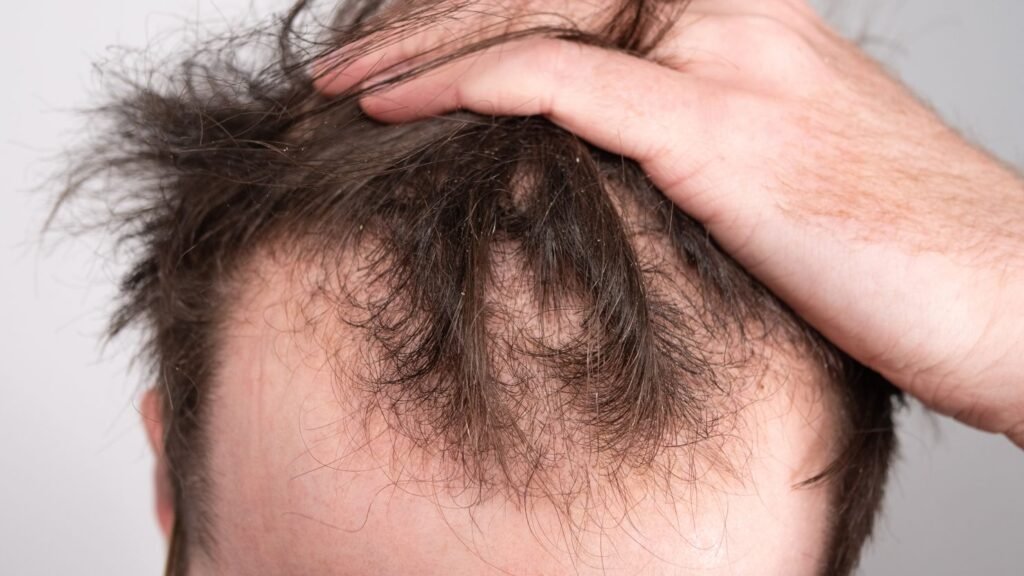Hair loss is a concern that affects millions of men worldwide, and with the rise of non-surgical options, Laser Hair Therapy—also known as Low-Level Laser Therapy (LLLT)—has become one of the most talked-about treatments. But does it really work? And is it worth the investment?
In this comprehensive guide, we’ll explore the science behind laser therapy for hair loss, how it works, who it’s best for, and what results you can realistically expect in 2025.
🔬 What Is Laser Hair Therapy?
Laser Hair Therapy, or Low-Level Laser Therapy (LLLT), is a non-invasive, FDA-cleared treatment that uses red or near-infrared light to stimulate hair growth at the cellular level. Unlike surgical procedures or drug-based treatments, LLLT aims to revive dormant hair follicles and improve hair density naturally.
Common device types include:
- Laser caps
- Helmets
- Combs
- In-office laser panels
These devices emit wavelengths between 630–670 nm, which penetrate the scalp and promote healthier, thicker hair growth.
🧪 How Does Laser Hair Therapy Work?
LLLT works through a process called photobiomodulation, where specific wavelengths of light:
- Increase cellular energy (ATP) production in hair follicle cells.
- Improve blood flow and oxygen delivery to the follicles.
- Reduce inflammation that may be contributing to follicular miniaturization.
- Prolong the anagen (growth) phase of the hair cycle.
- Stimulate dormant follicles to re-enter active growth.
The result? Thicker, denser hair in treated areas.
📊 What the Research Says: Is It Effective?
Laser therapy has been extensively studied in the past decade. Here’s a look at key findings:
- A 2014 study published in The American Journal of Clinical Dermatology found that men using LLLT devices had significantly improved hair density after 26 weeks compared to placebo.
- A 2020 meta-analysis in Lasers in Medical Science concluded that LLLT is safe and effective for androgenetic alopecia (male pattern baldness).
- FDA-Cleared Devices: Brands like HairMax, iRestore, and Capillus have received FDA clearance, meaning they’ve been shown to be safe and provide therapeutic benefit.
✅ Benefits of Laser Hair Therapy for Men
- Non-invasive and painless
- Drug-free alternative
- Can be used at home or in-office
- Suitable for all hair types and skin tones
- Combines well with other treatments (e.g., minoxidil, PRP)
❌ Limitations and Drawbacks
- Time commitment: Requires 15–30 minutes, 3–4 times per week.
- Slow results: Takes 3–6 months to see improvement.
- Best for early to moderate hair loss: Less effective for advanced balding.
- Ongoing use required: Discontinuing treatment may lead to regression.
🔄 LLLT vs Other Hair Loss Treatments
| Treatment | Invasiveness | Mechanism | Results Timeline | Best For |
|---|---|---|---|---|
| LLLT (Laser Therapy) | Non-invasive | Stimulates follicles via red light | 3–6 months | Early to moderate hair loss |
| Minoxidil | Topical | Increases blood flow to follicles | 4–6 months | Crown/vertex thinning |
| Finasteride | Oral | Blocks DHT hormone | 3–6 months | Genetic (DHT-related) hair loss |
| PRP Therapy | Minimally invasive | Growth factors injected into scalp | 3–6 months | Thinning or early bald spots |
| Hair Transplant | Surgical | Transplants healthy follicles | 6–12 months | Advanced hair loss |
💡 Who Is Laser Therapy Best For?
Ideal candidates:
- Men in early stages of male pattern baldness
- Men with diffuse thinning or a receding hairline
- Those looking for a natural, drug-free solution
- Post-transplant patients wanting to support follicle survival
Not ideal for:
- Men with fully bald areas (no active follicles left)
- Patients with inflammatory scalp conditions unless cleared by a doctor
🧢 At-Home vs In-Clinic Laser Devices
🏠 At-Home Devices (caps, combs, helmets)
- Convenient and cost-effective
- Good for long-term maintenance
- Requires strict adherence to schedule
🏥 In-Clinic Treatments
- Higher energy lasers
- Often combined with PRP or microneedling
- Supervised by medical professionals
2025 Update:
Smart laser caps now include AI feedback, app integration, and automatic session tracking to improve compliance and effectiveness.
💲 Cost of Laser Hair Therapy in 2025
- At-home laser caps: $500–$3,000 (one-time purchase)
- In-clinic sessions: $75–$200 per session
(Packages typically include 10–20 sessions)
🔁 How Long Do Results Last?
As long as you continue using the device consistently, results can be maintained. However, if treatment is stopped, hair follicles may revert to their previous thinning state within several months.
Many users combine LLLT with other treatments like:
- Minoxidil
- Finasteride
- PRP
- Hair vitamins (e.g., biotin, saw palmetto)
📸 Before and After: What to Expect
Months 1–3:
- Reduced hair shedding
- Healthier scalp appearance
Months 4–6:
- Increased hair thickness and density
- Noticeable regrowth in thinning areas
Months 6–12:
- Full results visible
- Maintenance phase begins
✨ Final Thoughts: Does Laser Hair Therapy Really Work?
Yes—for the right candidates, Laser Hair Therapy can be a powerful, drug-free tool for fighting hair loss. While it may not be a miracle cure or work for severe baldness, clinical studies and user reviews consistently show positive results when used consistently.
If you’re a man experiencing early signs of hair thinning or want to support other hair restoration treatments, LLLT may be a smart investment in your hair health and confidence.




